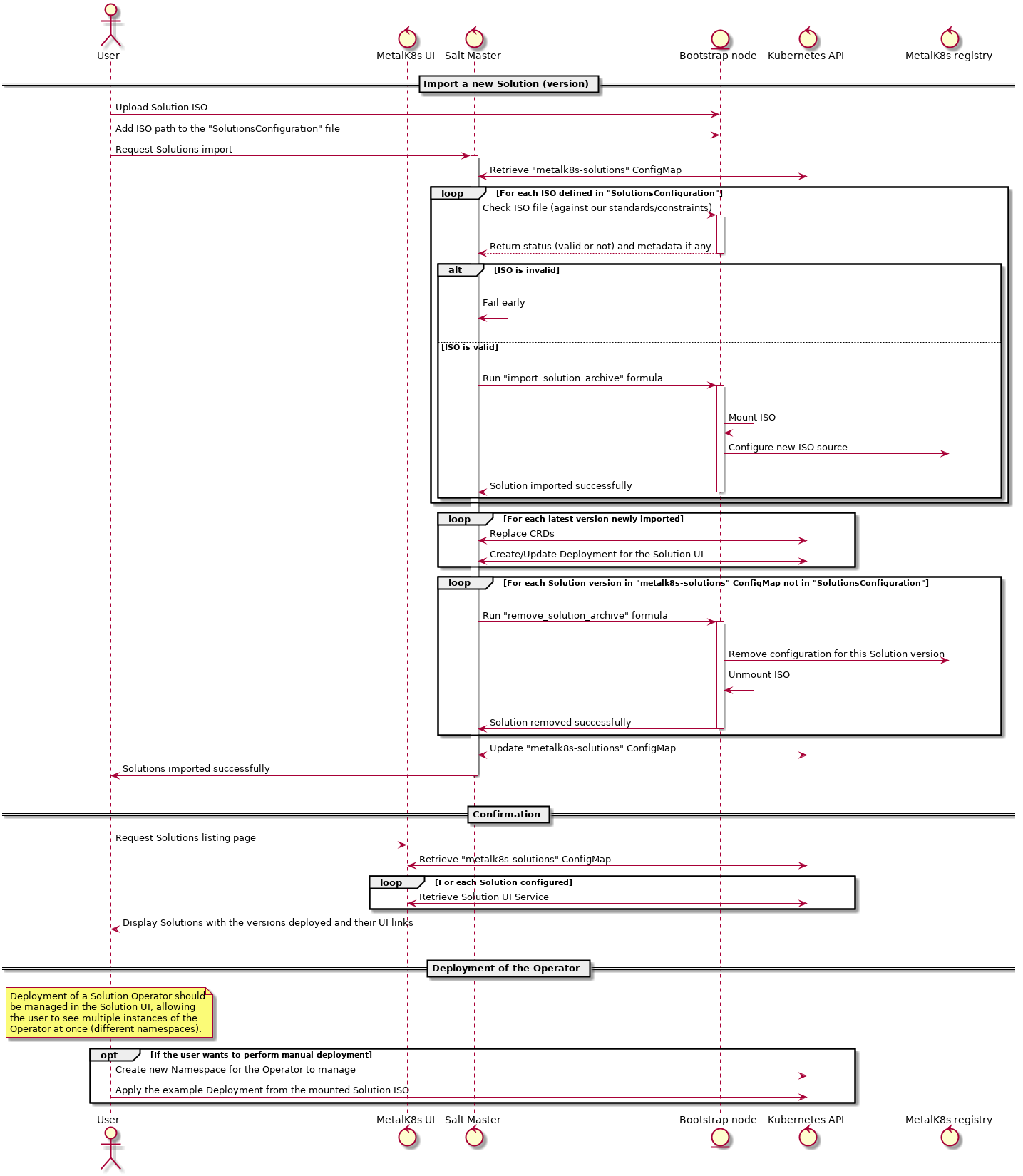Introduction¶
With a focus on having minimal human actions required, both in its deployment and operation, MetalK8s also intends to ease deployment and operation of complex applications, named Solutions, on its cluster.
This document defines what a Solution refers to, the responsibilities of each party in this integration, and will link to relevant documentation pages for detailed information.
What is a Solution?¶
We use the term Solution to describe a packaged Kubernetes application, archived as an ISO disk image, containing:
A set of OCI images to inject in MetalK8s image registry
An Operator to deploy on the cluster
Optionally, a UI for managing and monitoring the application, represented by a standard Kubernetes
Deployment
For more details, see the following documentation pages:
(TODO) Solution UI guidelines
Once a Solution is deployed on MetalK8s, a user can deploy one or more versions
of the Solution Operator, using either the Solution UI or the Kubernetes API,
into separate namespaces. Using the Operator-defined CustomResource(s), the
user can then effectively deploy the application packaged in the Solution.
How is a Solution declared in MetalK8s?¶
MetalK8s already uses a BootstrapConfiguration object, stored in
/etc/metalk8s/bootstrap.yaml, to define how the cluster should be
configured from the bootstrap node, and what versions of MetalK8s are available
to the cluster.
In the same vein, we want to use a SolutionsConfiguration object, stored in
/etc/metalk8s/solutions.yaml, to declare which Solutions are available to
the cluster, from the bootstrap node.
Todo
Add specification in a future Reference guide
Here is how it could look:
apiVersion: metalk8s.scality.com/v1alpha1
kind: SolutionsConfiguration
solutions:
- /solutions/storage_1.0.0.iso
- /solutions/storage_latest.iso
- /other_solutions/computing.iso
There would be no explicit information about what an archive contains. Instead, we want the archive itself to contain such information (more details in Solution archive guidelines), and to discover it at import time.
Note that Solutions will be imported based on this file contents, i.e. the images they contain will be made available in the registry and the UI will be deployed, however deploying the Operator and subsequent application(s) is left to the user, through manual operations or the Solution UI.
Note
Removing an archive path from the solutions list will effectively
remove the Solution images and UI when the “import solutions” playbook is
run.
Responsibilities of each party¶
This section intends to define the boundaries between MetalK8s and the Solutions to integrate with, in terms of “who is doing what?”.
Note
This is still a work in progress.
MetalK8s¶
MUST:
Handle reading and mounting of the Solution ISO archive
Provide tooling to deploy/upgrade a Solution’s CRDs and UI
MAY:
Provide tooling to deploy/upgrade a Solution’s Operator
Provide tooling to verify signatures in a Solution ISO
Expose management of Solutions in its own UI
Solution¶
MUST:
Comply with the standard archive structure defined by MetalK8s
If providing a UI, expose management of its Operator instances
Handle monitoring of its own services (both Operator and application, except the UI)
SHOULD:
Use MetalK8s monitoring services (Prometheus and Grafana)
Note
Solutions can leverage the Prometheus Operator CRs for setting up the monitoring of their components. For more information, see Monitoring and Solution Operator guidelines.
Todo
Define how Solutions can deploy Grafana dashboards.
Interaction diagrams¶
We include a detailed interaction sequence diagram for describing how MetalK8s will handle user input when deploying / upgrading Solutions.
Note
Open the image in a new tab to see it in full resolution.

Todo
A detailed diagram for Operator deployment would be useful (wait for #1060 to land). Also, add another diagram for specific operations in an upgrade scenario using two Namespaces, for staging/testing the new version.